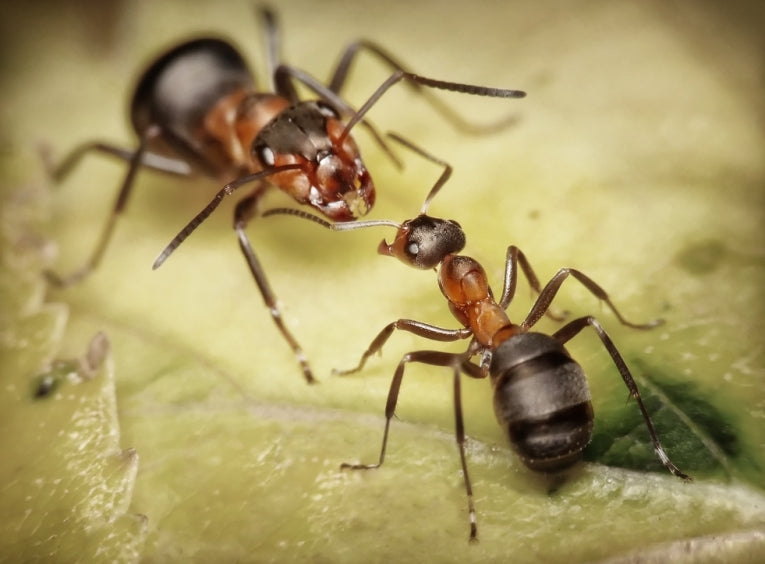Distance warfare has been thought to be a human development. Ants have beaten us to it long ago, though! Interspecific competition and wide ranging predations have helped both defence and offence mechanisms. The French (based in Toulouse) entomologists, Aline Rifflet, Nathan Tene, Jerome Orivel, Michel Treilhou, Alain Dejean, and Angelique Vetillard have published a fascinating paper, centred on a ground-living Cameroon species, Crematogaster striatula.
As this is Africa, termites are quite predominant in the ants' diet. As it's rainforest, the colonies have to defend themselves against very aggressive arboreal ant species. Achieving this defensive goal (especially in younger growth forest) is by means of secretions from the acid gland and the Dufour gland, both near the anus. Termites are much more affected by the toxic products, but this study also looked at the effect on other ant species.
Four colonies were used for the research. Plastic trays were used as a kind of experimental territory, which the workers readily marked. Termite workers and soldiers were the first investigated by being placed on the trays. Ant behaviour consisted of:
Next on the trays were neighbouring Formicid ants, Camponotus brutus., attracted by honey lures.Crematogaster workers discovered the rivals feeding on 24 occasions after short periods. Finally, two other territorially-dominant arboreal ants were also used on the trays.
As the behaviour on the trays always followed the stereotypic pattern above, the details for each attack are similar. Arriving workers positioned their abdomen when under a centimetre from the prey, with up to 15 workers involved in the "team." When very close, the venom was emitted, although not seen, and it took 10 minutes for a termite to begin to shake.. Without touching, the workers waited until leg movement slowed, then carried off the new food supply to the nest.

Workers firstly surrounded the termite at a distance of 5-10 mm, their abdominal tip pointed toward the prey. A. After ca. 10 minutes the termite fell down and rolled onto its back, its legs batting the air. One ant approached it very slowly. B. When there were fewer movements of its legs, all of the ants approached the termite. C. Later the ants prepared to seize the termite by an appendage to retrieve it to their nest. D. Interspecific competition. A Crematogaster striatula worker that had discovered several Camponotus brutus imbibing honey on its territory caused them to retreat by very slowly approaching in a backward movement, with its abdominal tip pointed toward the aliens. No contact between the antagonists was noted; Credit: PLoS ONE
With other prey, there was very little variation form this stereotype. Camponotus and the other ant species' workers were not carried off. They were simply excluded, expelled by the same toxic secretion, leaving the honey for the resident Crematogaster.
Meanwhile, the Dufour gland extract was assayed chromatographically, producing a list of 50 potential toxins. A few high molecular mass oxo-acetates seem likely candidates, but a nuclear magnetic resonance needs to be run to ascertain exact structures. The volatility of the secreted poison seems obvious from the workers' behaviour, while a large alkaloid is one of the likely acetates noted above.
Three functional chemicals are emitted by the ants. The short range recruitment is a pheromone effect while the defensive function was used against invading ants. The offensive use of toxins against prey is common in wood ants (Formicids)for a distance of up to 30cm.while many Arthropods can spray a defensive chemical, rather like a cobra. Primitive ants can use a mandibular poison, but the abdomen is the weapon of choice. European Crematogaster are known to secrete a froth of unsaturated keto-acetates and enzymes in a similar way to C. striatula. This mixture or precursors results in highly toxic aldehyde formation, with an acetic acid (vinegar) emission functions as the short term recruitment pheromone. Obviously the Cameroon species has a related number of chemicals, yet to be fully elucidated. The future applications of this toxin are unlimited.
Now for the useful nature of science. Insect species that have developed resistance to current insecticides can in future be treated to a volatile mix that is perfectly natural. What more could we want as allies in our war against the insect hordes?










